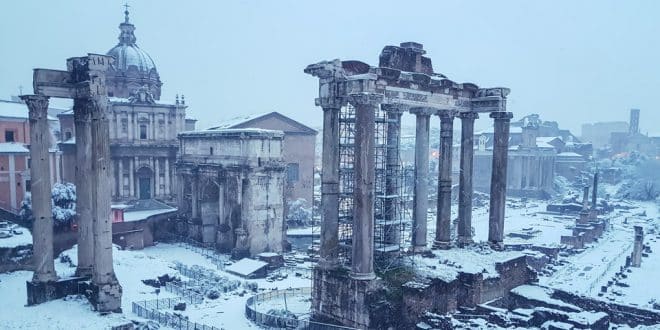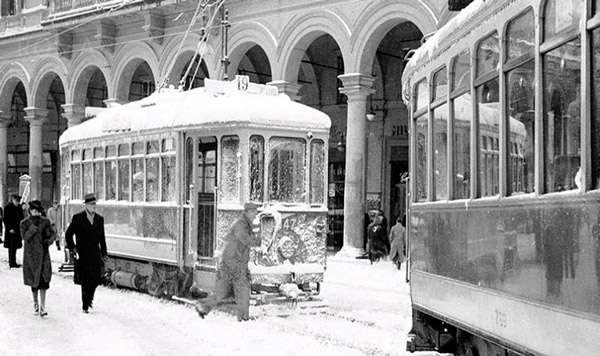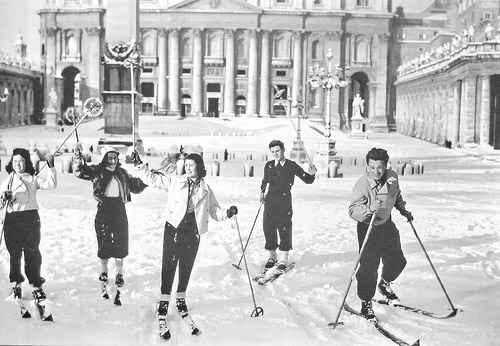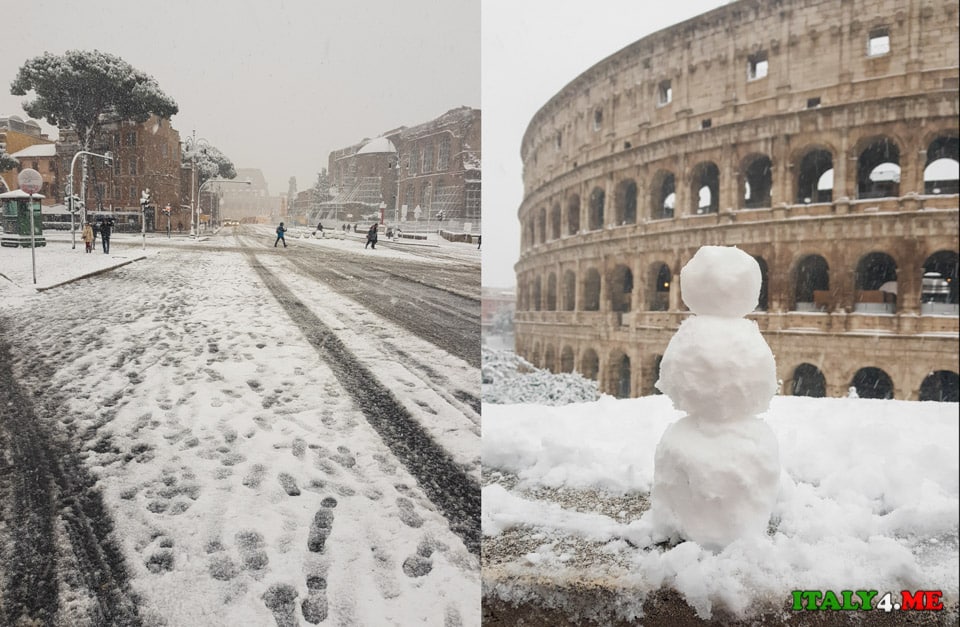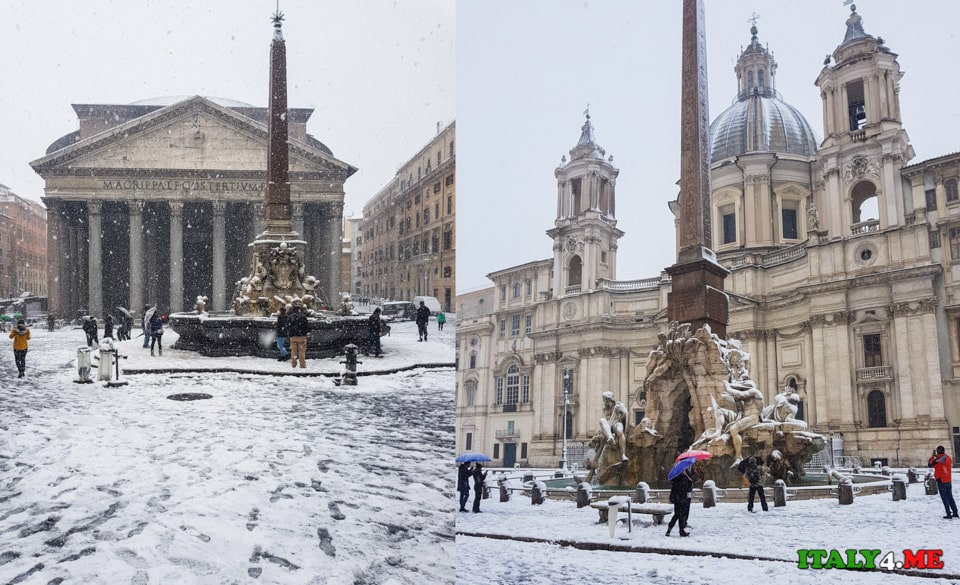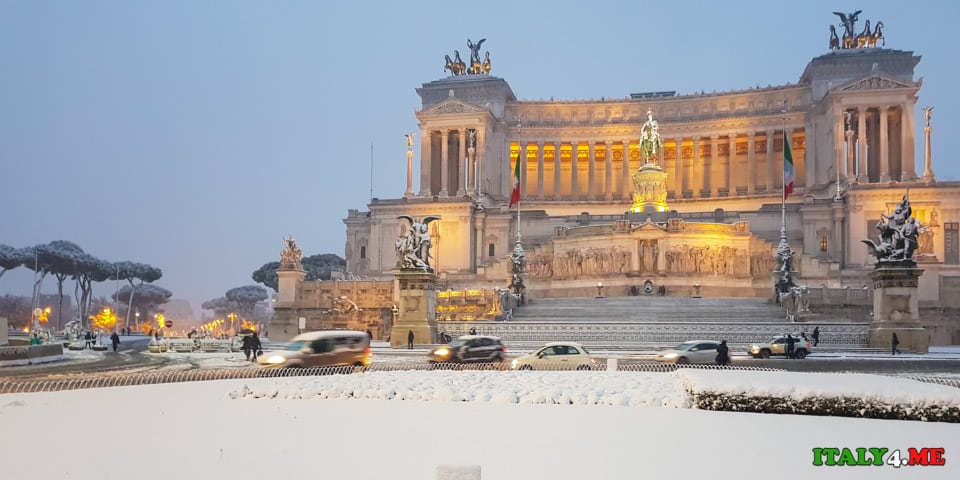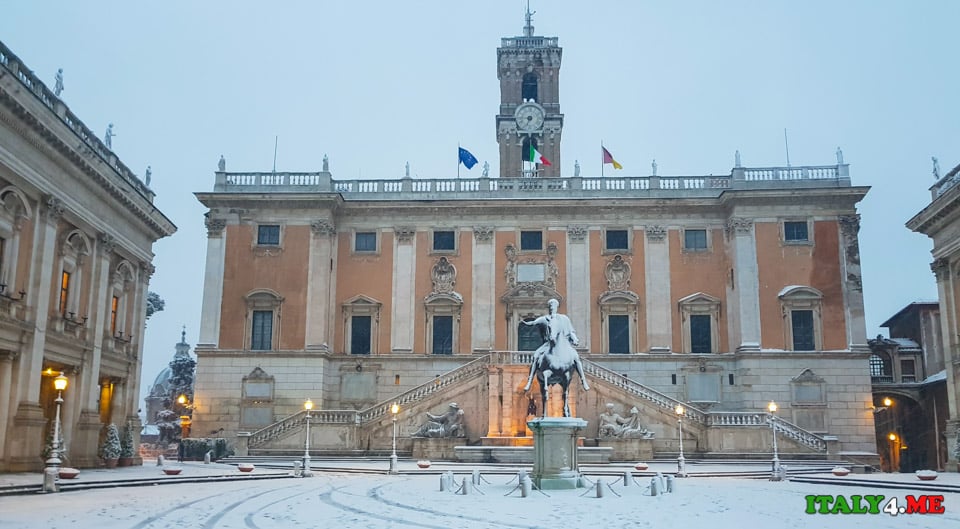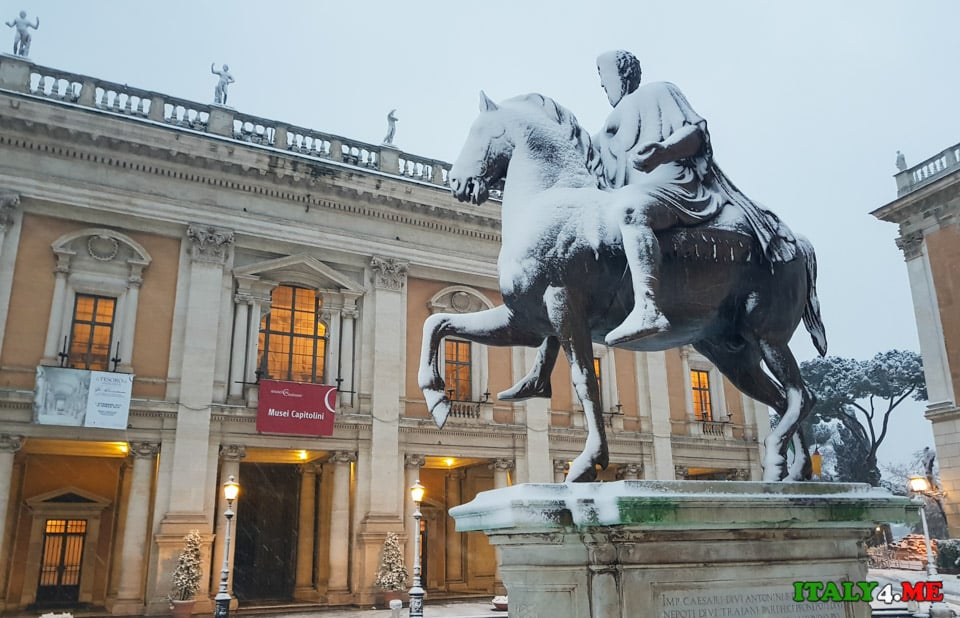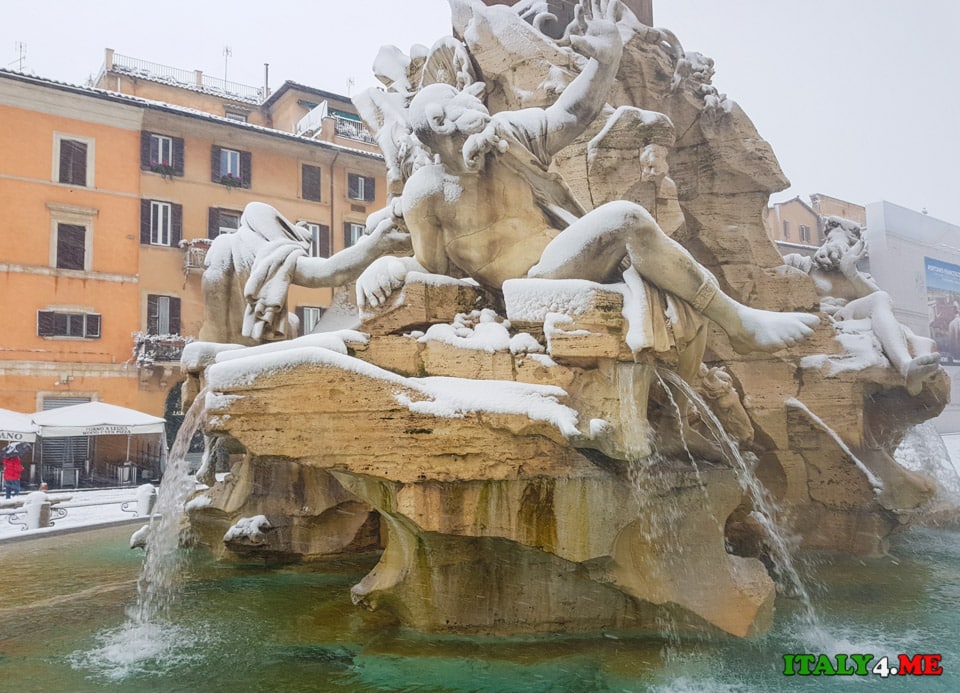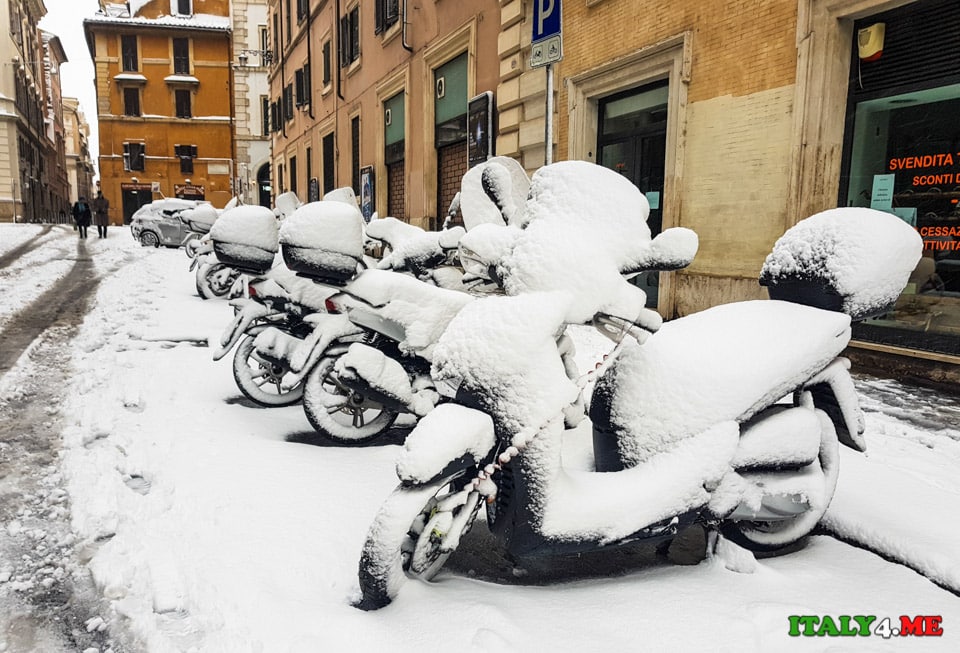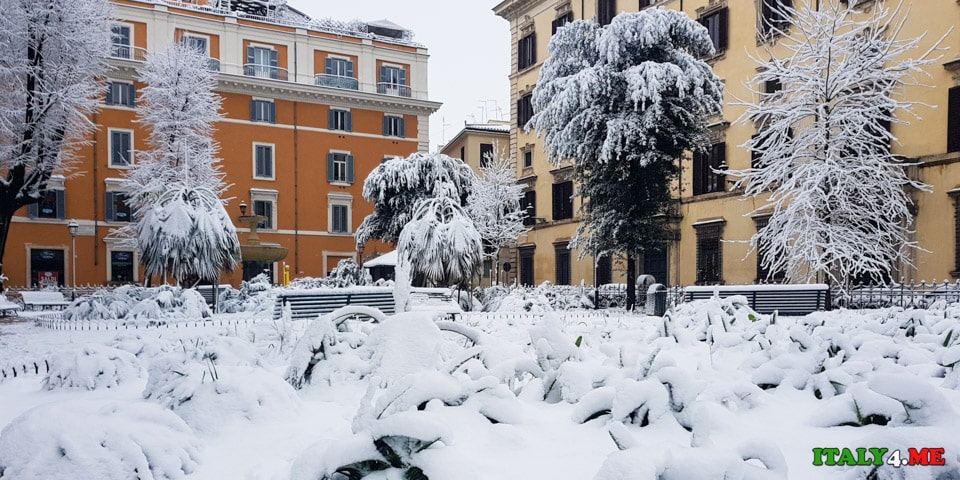Snow in the Eternal City is always something special. Not only because this phenomenon happens once in a decade or even less, but also because the grandiose cultural monuments covered with a soft white veil look fantastic. I’ll tell you everything I know about the real winter “Roman holidays.”
Page Contents
Why does it rarely snow in Rome?
Rome is a city located about 30 km away from the sea on the Tyrrhenian coast of the central part of the Italian peninsula. Such a geographical location explains why it does not snow in Rome.
It is known that the western part of Europe, based on macro geography, is a climatically very mild place due to the warm Gulf Stream. It comes from the Gulf of Mexico and warms the North Atlantic waters. Thus, the western part of the mainland becomes milder in the cold season compared with colder Central and Eastern Europe.
Local factors also play a significant role in the rare occurrence of snow. The Italian Tyrrhenian side at low altitudes is relatively “immune” to snow. For example, when cold air comes from northeastern Europe, the western part of the peninsula remains protected by the Apennines – they serve as a barrier that reduces air humidity. So, the snowfalls stay on the Adriatic side of Italy.
On the other hand, when the cold air passes in the broader circle, bypassing the Alpine arc and at the same time approaching the peninsula from the seaports, then the classical weather conditions on the Tyrrhenian coast are changing. So, central Italy is more affected. Although in this case, the cold air becomes more friendly than the direct flow.
However, when there is balance between the temperature and rainfall then it brings snow to Rome.
Types of snowfalls in Rome
Geographers and meteorologists distinguish 4 types of snowfall in Rome:
- The classic (most frequent) snowfall variant has 3 features. Firstly, the air going to the Tyrrhenian coast is very cold. Passing through the mountain barrier maintains the temperature required for winter precipitation. Secondly, the cyclone is heading from northwest of Rome, which contributes to the creation of “productive cloudiness.” Thirdly, the area with the least pressure at the land surface is located between the middle-low part of Sardinia (Sardegna) and central Campania (Campania). If all three features combine, moderate snow is possible in the northeast and southwest of the capital.
- Icy air comes from the northeast, and a minimum of pressure is observed both in the central regions of the republic and on the Tyrrhenian coast. When atmospheric instability occurs, even snow storms are likely to appear.
- The third type of snowfall occurs when the cold air inlet is located in the north and the zone of minimum atmospheric pressure in the east (for example, in Venice). In this situation, winter precipitation appears on the high Tyrrhenian hills and can only partially reach the outskirts of Rome. That’s why it will hardly snow.
- The last configuration is also very rare. It occurs when a cold front moves from France through Liguria (Liguria) and Tuscany (Toscana). And only the coincidence of a considerable number of factors can cause short snow, which quickly turns into rain.
To sum it up, it is worth noting that Rome, like any large metropolis, is a powerful “heat island” due to asphalt and many buildings. Therefore, the temperature in the city in winter is several degrees higher than in the surrounding areas.
History of snowfalls
The earliest meteorological records of snowfall in Rome date back to 1788. According to the papers, in the period from the end of the 18th to the beginning of the 20th century, winter precipitation appeared in the capital with intervals ranging from 5 to 30 years.
However, everything changed in the last century. Snow falls in the eternal city every 3-4 years. And during the Second World War, snowfalls were annual:
- December 1939: 30 cm of snow.
- December 1940: Piazza Venezia and the San Saba area are covered in snow. Snow coverage was 4-6 cm.
- December 1941: Snow over a wide area of the capital. The thickness was up to 7 cm.
- January-February 1942: 3.3 cm of snow in some areas of the city – Parioli, Esedra.
- January 1945: 3 cm snow with freezing rain.
Although 1956 was remembered for severe frosts and prolonged snow. Beginning in January, periodic snowfalls continued until mid-March. These events shocked the Italians so much that they wrote several songs about it.
For example, the famous hit of Luigi Lopez and Carla Vistarini with the same name, “La nevicata del ’56” (Snowfall 56), was performed by Mia Martini at the San Remo festival in 1990, where she won the Critics’ Award.
The next significant snowfall took place in 1985. Up to 15 cm of precipitation fell in the first days of January.
The snowfall of ‘86 quickly disappeared due to rising temperatures.
February 6, 1991, was marked by several hours of the most beautiful flight of snowflakes. The result: stunning landscapes of snowy Rome, captured in photographs.
Occasional snowfalls in the winters of 1999, 2002, 2004, 2005, and 2010.
Significant snowfall happened in the capital in February 2012. February 3 and 4, the height of snow cover in the northern parts of the city reached 20 cm.
Snowfall February 26, 2018
For almost 6 years, the Eternal City lived without climatic fluctuations and for the last 5 of them I dreamed of seeing snow in Rome! The stories and memories of local residents stirred my heart.
I couldn’t believe my eyes early in the morning when I opened my eyes and saw snow! We dressed up quickly and headed for a walk around the city.
Heavy snowfall at night and in the morning brought from 10 to 15 cm of precipitation. As it turned out, it was caused by a massive cold front moving from Siberia. Some Western media called it “The Beast from the East.” As a result, the temperature dropped to -9 degrees rather abruptly. The paradox of the situation was that we came back from our trip around Siberia precisely the day before.
The mayor of Rome, Virginia Raggi, ordered to close off public schools. Many private institutions closed as well. Utilities deployed about 190 vehicles and nearly 1,500 people to clear the streets in the aftermath of the snowfall. Drivers whose cars were not equipped with winter tires were advised not to drive on the roads. In fact, that was it.
The Colosseum (Colosseo), Palatine Hill (Monte Palatino) and the Roman Forum (Forum Romanum), and other sights of the capital, were also closed to visitors.
At several railway stations, the authorities set up temporary shelters for the homeless and distributed 1,000 blankets. Besides, one shelter was opened to warm up homeless animals.
While the managers were busy solving a sudden problem, the inhabitants and guests of Rome enjoyed the onset of such a rare and short winter. People armed themselves with improvised plastic bag sleds and were rolling down the hills. The more agile managed to get skis and saucers. And, of course, many great photos and videos were created in the most picturesque places of the city. Those days, the hashtags #nevearoma and #snowinRome were the most popular on Instagram.
some
Photos
On our official Facebook page, you can see an album with an extensive collection of photos of snowy Rome in different years. I will publish here the most significant ones so that you can feel at least a bit of the atmosphere of this unique event.
Pantheon and Piazza Navona.
The Altar of the Fatherland (Altare della Patria) and the snow-covered Piazza Venezia.
And here is happy me with my happy wife, Yana. I confirm that it was a little chilly in sneakers, but Yana strategically put on a hat from Siberia.
Empty and wonderful Capitoline Square – when will we see it again?
Marcus Aurelius also got a snow cover.
The sculptures of the fountain of the 4 rivers (Fontana dei Quattro Fiumi) on Piazza Navona.
The scooter drivers decided to stay at home that day.
The Benedetto Cairoli Park (Parco De La Piazza Benedetto Cairoli) next to Piazza Argentina was incredibly beautiful!
And this is how an ordinary district street looked at 10 a.m. – no one went to work.
The next day, February 27, I was jogging at Villa Doria Pamphilj, where blue skies and snowy pines awaited me. My dream came true. Thank you, Rome!
Video
You can watch our stream from snowy Rome here:
- The Forum and the Colosseum – it was viewed by more than 88.000 people.
- The Pantheon
 Italy for me From Italy with love
Italy for me From Italy with love

